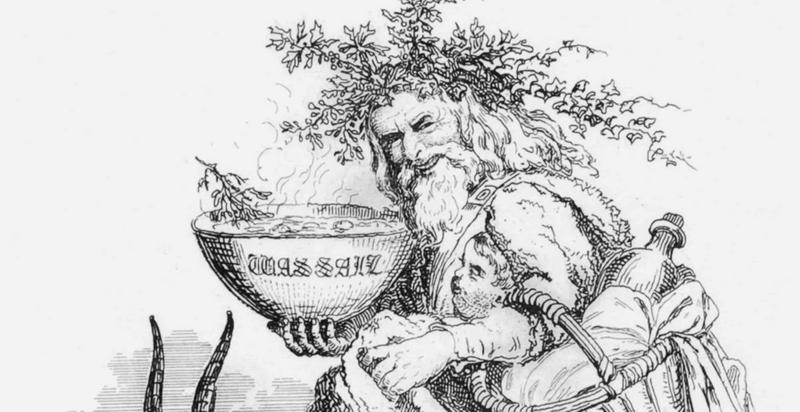Wassail: The Yuletime Tradition
By Linda Speckhals | December 5, 2022

The term can be used to refer to the beverage, the celebration, and even be used as wassailing or reveling. Wassailing, as a custom, may have originated in Ancient Rome from the sacrifices made to Pomona, the Roman Goddess of Fruits. In England, according to one legend from Geoffrey of Monmouth, who wrote the History of the Kings of Britain in 1135, wassailing originated with a 5th-century king, Vortigern. During a royal banquet, Rowena, or Renwein, a beautiful Saxon maiden, gave Vortigern a bowl of wine, saying “Lavert King, waes hael.” He responded with “drinc hael,” establishing the tradition that the first to drink at a banquet says “waes hael.” The toast “waes hael” likely comes from the Old Norse “ves heil” which translates to “be whole” or “good health.” The word had moved from referring to the toast, to referring to the drink, by about 1300. The first recorded use of the term to mean “reveling” came in Shakespeare’s Hamlet.
What Was The Drink?
The wassail existed throughout pre-Christian times in Britain, when the Anglo-Saxons celebrated the New Year in the halls of the Lord of the Manor. This celebration included a giant bowl often made of pewter or silver and filled with a type of punch that was a mix of cider, ale, and mead infused with spices and crab apples. According to some sources, the wassail was made of mulled ale, curdled cream, roasted apples, eggs, cloves, ginger, nutmeg, and sugar. This particular mixture was occasionally called “lamb’s wool,” because the roasted apple pulp was frothy and looked a bit like lamb’s wool.

It's Celebrated On Twelfth Night
Wassail is celebrated in the UK on Twelfth Night, which is the pagan New Year’s Eve. Commonly, it's considered January 6, but if you look back to the roots of the celebration, the pagan New Year is actually January 17. It only became January 6 when Britain switched to the Gregorian calendar in 1752. Some still celebrate it on January 17, while some celebrate on January 5, the eve of Epiphany. The celebration happened at dusk, the time of day when the realm of fairies and spirits was juxtaposed with the realm of man.
The Ceremony Was Held In An Apple Orchard
The earliest accounts of wassailing come from St. Albans in 1486 and Kent in 1585, and the ceremonies with their unique traditions, symbols, and rituals differ between regions, villages, and even farms. Typically, the wassail started with a torch-lit procession in the cider orchard as the wassail was, in part, a blessing on the trees so they would bear fruit for making cider. As the celebrants traveled through the orchard, they banged pots and pans to warn off insidious forces. They were often led by a Wassail King and Queen, and a Master of Ceremony, called the Butler, who dressed in black, and who called the congregation to gather around the largest tree in the orchard. The Butler then led everyone as they sing songs to the apple goddess, Pomona, asking for a healthy harvest. As part of the ceremony, the smallest boy, called the Tom Tit, was lifted up to put cider-soaked bread on the branches of the tree for good luck, or it may be that they are feeding the trees and thanking them for providing the apples. This part of the ceremony may also be performed by the Queen. Then, to ensure that the malevolent forces are nowhere near the orchard, shotguns were fired. However, they may also be making a ruckus to “awaken” the trees in hopes of getting a good crop.

The Apple Tree Man
Related to the ceremony, there is a folktale in Somerset about the Apple Tree Man. The Apple Tree Man is said to be the spirit of the oldest apple tree in the orchard; the orchard’s fertility resides in this spirit. According to the folktale, the Apple Tree Man reveals the location of buried gold when a man offers his last mug of mulled cider to the trees.
It Evolved Into Caroling
This tradition continued across the centuries as people blessed, toasted, shared, and gave thanks throughout the Yuletide. In Victorian England, they took the spirit of generosity further as they wassailed from door to door. With this, the less fortunate traveled from door-to-door wassailing, and they sang in exchange for charitable gifts. Over time, this became the tradition of Christmas caroling, and instead of wassail, they began sharing mulled cider. For all of its changes, and in spite of the different customs, all wassailing shares some common ground: it provides an opportunity for community members to come together, give thanks, and share in traditions.